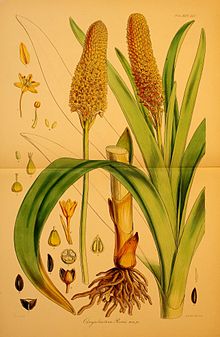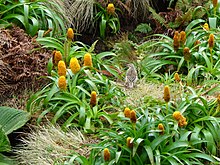Bulbinella
| Bulbinella | ||||||||||||
|---|---|---|---|---|---|---|---|---|---|---|---|---|

|
||||||||||||
| Systematics | ||||||||||||
|
||||||||||||
| Scientific name | ||||||||||||
| Bulbinella | ||||||||||||
| Kunth |
Bulbinella is a genus of plants withinthe grass tree family (Xanthorrhoeaceae). The approximately 24 species occur only in the southern hemisphere in a disjoint area : around 18 species are native to South Africa and around six species in New Zealand .
Description and ecology


Appearance and leaves
The Bulbinella species grow as perennial, herbaceous plants that reach heights of 35 to 100 centimeters, depending on the species. As survival organs, they form compact , subterranean rhizomes that are surrounded by small, scale-like, membranous lower leaves and often by fibrous remains of the leaf base. They stand alone or form clumps . The roots are a bit fleshy.
These are geophytes in which the leaves dry up during the dry season and fresh leaves sprout again in the rainy season , which are often also present during the flowering period. The South African Bulbinella species are green in winter. A few to several leaves are arranged in a spiral in basal rosettes . The somewhat fleshy, simple leaf blades are round or triangular in cross section and belt-shaped and keeled. The leaf margins are smooth or serrated. There is parallel nerve.
Inflorescences, flowers and pollination
There is a leafless, short to long inflorescence stem. The flowers are in more or less dense, unbranched, racemose inflorescences together. There are small, paper-like bracts . The thin flower stalks are usually long, rarely reduced.
The rarely fragrant, if musty smelling, hermaphrodite flowers are radial symmetry and threefold. The usually six equally shaped bracts are free or only fused at their base and arranged in a star or cup shape. The color of the attractive bracts is white to cream or yellow to orange. There are two circles with three identical stamens each. The bare stamens are inserted below the ovary and fused with the base of the bracts. Three carpels are an egg-shaped, dreikammerigen, Upper permanent ovary grown. Each ovary chamber contains only two ovules . The stylus is slim.
Most South African species bloom in late winter, spring and summer, i.e. between June and January, but bloom in the drier season between December and June. The New Zealand species mostly bloom in the summer between November and January. The pollination is done by insects, particularly honey bees. As an exception within the Asphodeloideae, Bulbine and Bulbinella do not produce nectar and pollen is the only reward for the pollinators. Beetles have been observed on some species, e.g. Bulbinella eburniflora , and they may also play a role in pollination.
Fruits and seeds
The spherical to egg-shaped capsule fruits contain only one or two seeds in each fruit compartment. The flattened egg-shaped and shield-shaped seeds have a black seed coat and a wing lying on the edge.
Chromosome number
The basic chromosome number is x = 7.
Occurrence
The genus Bulbinella only has a disjoint area in the southern hemisphere . About 18 species are elements of the Capensis , they occur in South Africa ( North Cape , Western Cape and Eastern Cape ). About six species are native to the North and South Islands of New Zealand .
Most species thrive in winter rain areas in South Africa, mostly in damp and cool locations.
Some Bulbinella species are in the "Red List of South African Plants".



Systematics
The genus Bulbinella was established in 1843 by Karl Sigismund Kunth in Enumeratio Plantarum Omnium Hucusque Cognitarum , 4, p. 569. Bulbinella triquetra (Lf) Kunth was specified as the lectotype species in 1951 by Edwin Percy Phillips in The Genera of South African Flowering Plants , 2nd edition, p. 183. The genus name Bulbinella refers to the similarity to the genus Bulbine , from which it differs mainly in the bald stamens instead of the hairy ones in Bulbine . Before Kunth's studies, these species were part of the polymorphic genus Anthericum . A synonym for Bulbinella Kunth is Chrysobactron Hook. f. .
The genus Bulbinella belongs to the subfamily Asphodeloideae within the family Xanthorrhoeaceae . It used to be part of the Liliaceae family.
There are about 24 Bulbinella - types :
- Bulbinella angustifolia (Cockayne & Laing) LBMoore : It isnativeto the South Island of New Zealand .
- Bulbinella barkerae P.L. Perry : It occurs in the Western Cape . The stocks are considered stable. It is classified as “least concern” = “not at risk”.
- Bulbinella calcicola J.C. Manning & Goldblatt : This rare species, first described in 2010, only occurs in a rare vegetation formation on limestone cliffs in Saldanha Bay on the Vredenburg peninsula in the Western Cape . There are only 400 specimens in just one location. It is endangered, for example, by mining, which has already lost 90% of the population. It is classified as "Critically Endangered" = "threatened with extinction".
- Bulbinella cauda-felis (L. f.) T.Durand & Schinz : It occurs in the Western Cape and North Cape . The stocks are considered stable. It is classified as “least concern” = “not at risk”.
- Bulbinella chartacea P.L. Perry : It occurs in the Western Cape. The stocks are considered stable. It is classified as “least concern” = “not at risk”.
- Bulbinella ciliolata Kunth : It occurs in the North Cape. The stocks are considered stable. It is classified as “least concern” = “not at risk”.
- Bulbinella divaginata P.L.Perry : It occurs in the Western and Northern Cape. The stocks are considered stable. It is classified as “least concern” = “not at risk”.
- Bulbinella eburniflora P.L. Perry : This endemic occurs only in the Bokkeveld Escarpment in the North Cape. The loss of habitat through pasture management since 1940 has been over 80%. The plants are very sensitive to interference from grazing animals. There are only small, isolated locations. Climate change also appears to be affecting stocks. It thrives in the Renosterveld on clay soils in the Tillit slate plains. It is classified as "vulnerable" = "at risk".
- Bulbinella elata P.L. Perry : It occurs in the Western and Northern Cape. The stocks are considered stable. It is classified as “least concern” = “not at risk”.
- Bulbinella elegans Schltr. ex PLPerry : It occurs in the Western and Northern Cape. The stocks are considered stable. It is classified as “least concern” = “not at risk”.
-
Bulbinella gibbii Cockayne : There are two varieties:
- Bulbinella gibbsii var. Balasifera L.B.Moore : It is common on the North and South Island of New Zealand.
- Bulbinella gibbsii Cockayne var. Gibbsii : It only occurs on Stewart Island .
- Bulbinella gracilis Kunth : It occurs in the Western and Northern Cape. The stocks are considered stable. It is classified as “least concern” = “not at risk”.
- Bulbinella graminifolia P.L. Perry : It occurs in the Western and Northern Cape. The stocks are considered stable. It is classified as “least concern” = “not at risk”.
- Bulbinella hookeri (Colenso ex Hook.) Cheeseman : It is native to New Zealand.
-
Bulbinella latifolia Kunth : There are four subspecies:
- Bulbinella latifolia subsp. denticulata PLPerry: It occurs in the Western Cape. The stocks are considered stable. It is classified as “least concern” = “not at risk”.
- Bulbinella latifolia subsp. doleritica (PLPerry) PLPerry: This endemic occurs only in the Bokkeveld Escarpment in the North Cape. This habitat specialist is only known from seven locations. The stocks are continuously decreasing. It is classified as "vulnerable" = "at risk".
- Bulbinella latifolia Kunth subsp. latifolia : It occurs in the North Cape. The stocks are considered stable. It is classified as “least concern” = “not at risk”.
- Bulbinella latifolia Kunth subsp. toximontana PLPerry: It thrives in the fynbos in Gifberg and the Matsikamma mountains in the Western Cape. The stocks are considered stable. It is classified as "vulnerable" = "at risk".
- Bulbinella modesta L.B.Moore : It is native to the South Island of New Zealand.
- Bulbinella nana P.L. Perry : This endemic is only known from two localities in the northern Namaqualand , Steinkopf and Springbok in the North Cape. It thrives in the succulent karoo in the Namaqualand-Klipkoppe bushland on soils above granite. The stands are potentially endangered by overgrazing, but are considered stable. It is classified as "vulnerable" = "at risk".
-
Bulbinella nutans (Thunb.) T.Durand & Schinz : The two subspecies are classified as "least concern" = "not endangered":
- Bulbinella nutans (Thunb.) T. Durand & Schinz subsp. nutans : It occurs in the Western and Northern Cape. The stocks are considered stable.
- Bulbinella nutans subsp. turfosicola (PLPerry) PLPerry : It occurs in the Western and Northern Cape. The stocks are considered stable.
- Bulbinella potbergensis P.L.Perry : From this endemic only two localities on the north side of Potberg chain in the Western Cape are known. The populations are threatened by agriculture, habitat degradation and invasive plant species. It thrives in the fynbos and the stocks continue to decline. It is classified as "Critically Endangered" = "threatened with extinction".
- Bulbinella punctulata numberbr. : It occurs in the Western Cape. The stocks are considered stable. It is classified as “least concern” = “not at risk”.
- Bulbinella rossii (Hook. F.) Cheeseman : It occurs on the Auckland Islands and Campbell Island .
- Bulbinella talbotii L.B.Moore : This endemic is only found in Gouland Downs on the South Island of New Zealand.
- Bulbinella trinervis (Baker) PLPerry : It occurs in the Eastern Cape and Northern Cape. The stocks are considered stable. It is classified as “least concern” = “not at risk”.
- Bulbinella triquetra (L. f.) Kunth : It occurs in the Western and Northern Cape. The stocks are considered stable. It is classified as “least concern” = “not at risk”.
use
Only the New Zealand Bulbinella species, especially Bulbinella hookeri and Bulbinella rossii, are actually used as ornamental plants .
swell
- John C. Manning , Peter Goldblatt & Deirdré A. Snijman : The Color Encyclopedia of Cape Bulbs , 2002, Timber Press, Portland. ISBN 0-88192-547-0 : Bulbinella on pp. 100-106. (Section Description, Occurrence and Use)
- Stephen Boatwright & John Manning, September 2012: Bulbinella Kunth at PlantZAfrica from the South African National Biodiversity Institute = SANBI. (Section Description, Occurrence and Use)
Individual evidence
- ↑ a b c d e f g h i j k l Stephen Boatwright & John Manning, September 2012: Bulbinella Kunth at PlantZAfrica from the South African National Biodiversity Institute = SANBI. Retrieved February 3, 2013
- ↑ a b c d e f g h i j John C. Manning , Peter Goldblatt & Deirdré A. Snijman : The Color Encyclopedia of Cape Bulbs , 2002, Timber Press, Portland. ISBN 0-88192-547-0 : Bulbinella on pp. 100-106.
- ↑ a b c d e f g h i j k l m n o p q r s t u v w Raimondo et al., 2009: Bulbinella in National Assessment: Red List of South African Plants . Retrieved February 3, 2013
- ^ Bulbinella at Tropicos.org. Missouri Botanical Garden, St. Louis, accessed February 3, 2013.
- ^ A b Bulbinella in the Germplasm Resources Information Network (GRIN), USDA , ARS , National Genetic Resources Program. National Germplasm Resources Laboratory, Beltsville, Maryland. Retrieved February 3, 2013.
- ↑ a b c d e f g h Rafaël Govaerts (Ed.): Bulbinella. In: World Checklist of Selected Plant Families (WCSP) - The Board of Trustees of the Royal Botanic Gardens, Kew . Retrieved October 13, 2014.
Supplementary literature
- Pauline L. Perry: Systematic Studies in the Genus Bulbinella Kunth (Asphodelaceae) , University of Cape Town, 1987.
- Pauline L. Perry: A synoptic review of the genus Bulbinella (Asphodelaceae) in South Africa , In: South African Journal of Botany , Volume 53, 1987, pp. 431-444.
- Pauline L. Perry: Bulbinella in South Africa , National Botanical Institute , 1999 ISBN 978-1-919795-46-1 .